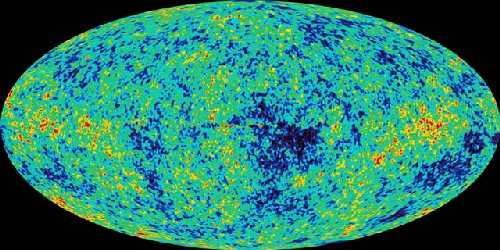Looking to the bottom of
time
|
| If you can't imagine a four-dimensional
space-time (can you? I can't), at least some cosmological facts may be
envisioned by scaling down the problem to a lower level. Let's imagine
we are living on the surface of a sphere without knowing it. That shouldn't
be too difficult, since we did exactly that for many millenia. Now let's
imagine a very distant view, and let's assume further that photons are
allowed to travel only in the surface of the sphere. What would happen
if we would peer into really very far? Of course you might expect that
a very enduring photon should eventually travel around the whole "universe",
and finally we should be able to see our own behind. |
| We have just overlooked one tiny detail
in our nice thought experiment: We forgot that the photon takes some
time for this journey. A whole lot of time. Such a long time that it
is very unlikely that we would ever live to see our own behind. What would
we see? Our world as it was 100 years ago? 1000 years ago? No chance.
We wouldn't see anything of "our world". In reality, the Hubble Space
Telescope looks back into space-time by more than 10 billion years, and
it still doesn't see itself from behind. At that time, there was no mankind
yet, there was no earth, there was no sun. Most likely, there wasn't even
our Milky Way as we know it. But still it hasn't looked to the end of time. |
| What would we see if we looked to the
end of time? Well, the COBE Differential Microwave Radiometer has done
that, at least almost so (Partridge 1992). In 1964, Penzias & Wilson
stumbled over a curious phenomenon, that earned them each a quarter of the
physics Nobel Price in 1978.
From all directions of the sky, a faint but remarkebly homogenous microwave
radiation can be recorded, spectrally equivalent to the heat radiation
from a black body with a temperature of exactly 2.728 ± 0.002 K
(cited in Dodelson et al. 1996). The satellite-born COBE instrument screened
the cosmic space in all directions and detected slight anisotropies in that
background radiation, in the range of 10 ppm. What kind of "black body"
was the source of this radiation? |
| The theory goes like this (Hu et al.
1997): All these photons originated at the same time, due to the same
event. At the time of their generation, their energy spectrum corresponded
to a temperature of 3 000 (three thousand) K. Cooling down to 2.728 (i.e.
slightly below 3) K took them about 13.7 billion years. These photons correspond
to the first light of the developing universe, emanated 379 000 years after
the Big Bang. Before that time, the universe was too hot to allow the formation
of atoms and was dominated by a particle soup hindering the photons to travel
relevant distances. Only after the formation of (hydrogen) atoms the universe
became transparent to light. Maybe you feel reminded now of Genesis
1:3 (God said, "Let there
be light," and there was light). Now we know that this didn't happen on
the second day of creation, but in its 379 000th
year. |
| The anisotropies recorded by COBE are
regarded as the "seeds of cosmic structure", a reflection of the first
density fluctuations in the primordial particle soup. Later, these fluctuations
gave rise to the formation of the first stars, and are believed to have
founded the large-scale distribution of galaxy clusters as observed today
(Boughn & Crittenden 2003). The origin of the cosmic microwave background
marks the earliest event in the history of our universe that theoretically
could be seen. Beyond that moment, the universe was pitch-dark. In other
words: We cannot see to the very bottom of time, not even with a super-Hubble
telescope. The last picture we see, allthough cosmologists are happy with
anisotropies in the 10 ppm range, is blurred and devoid of explicit structure
- and surely is not showing our behind. |
| More... |
